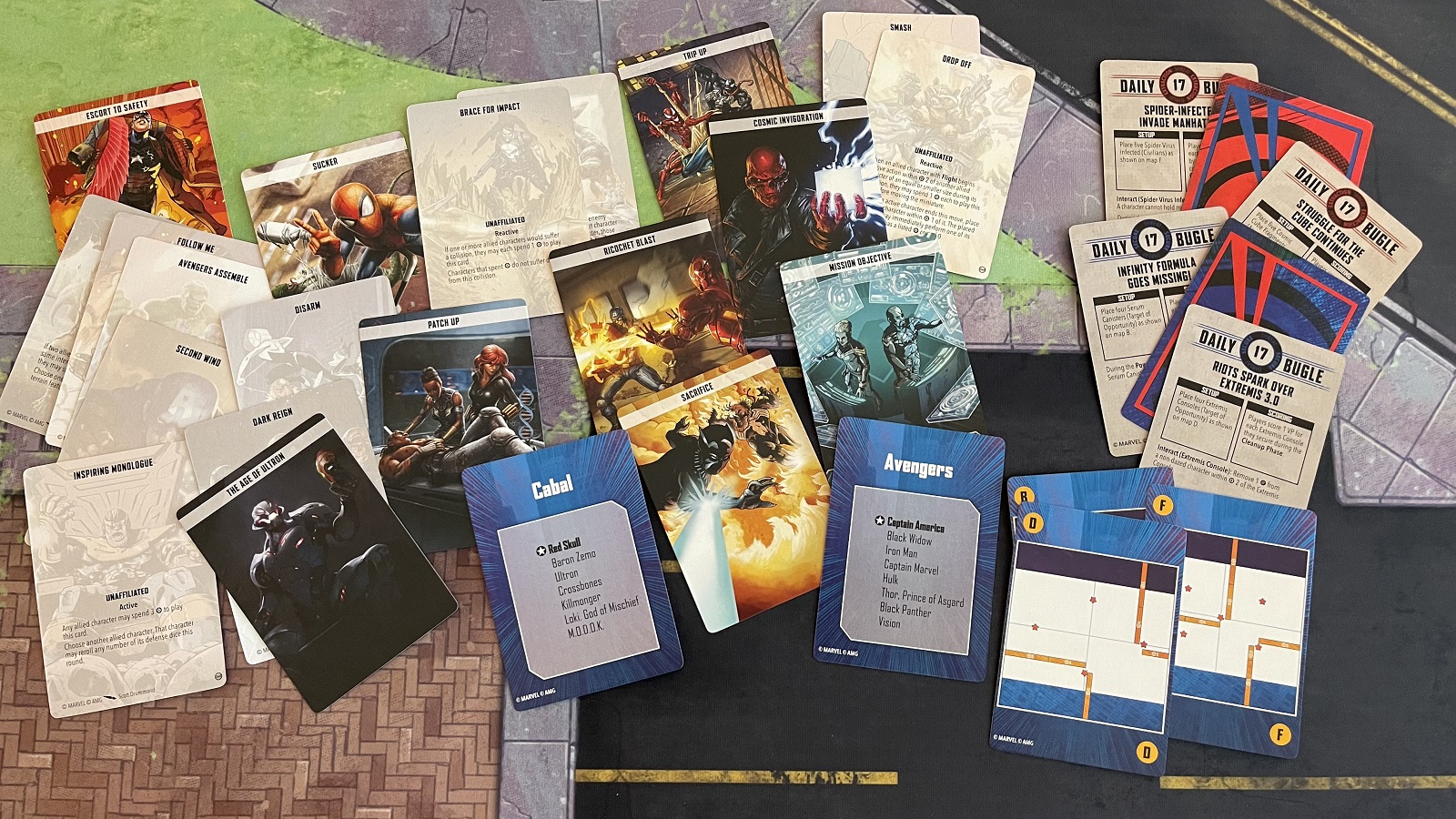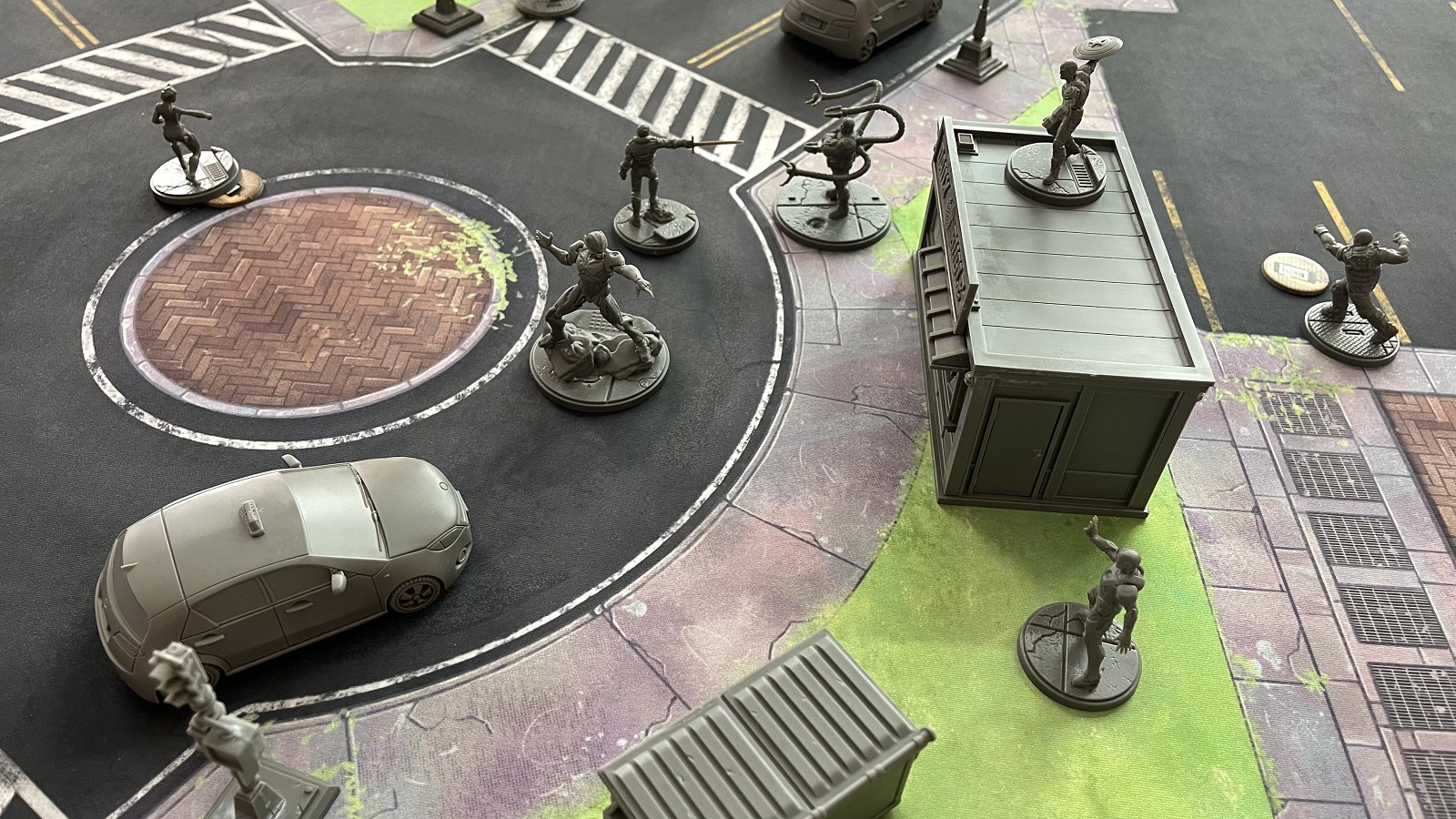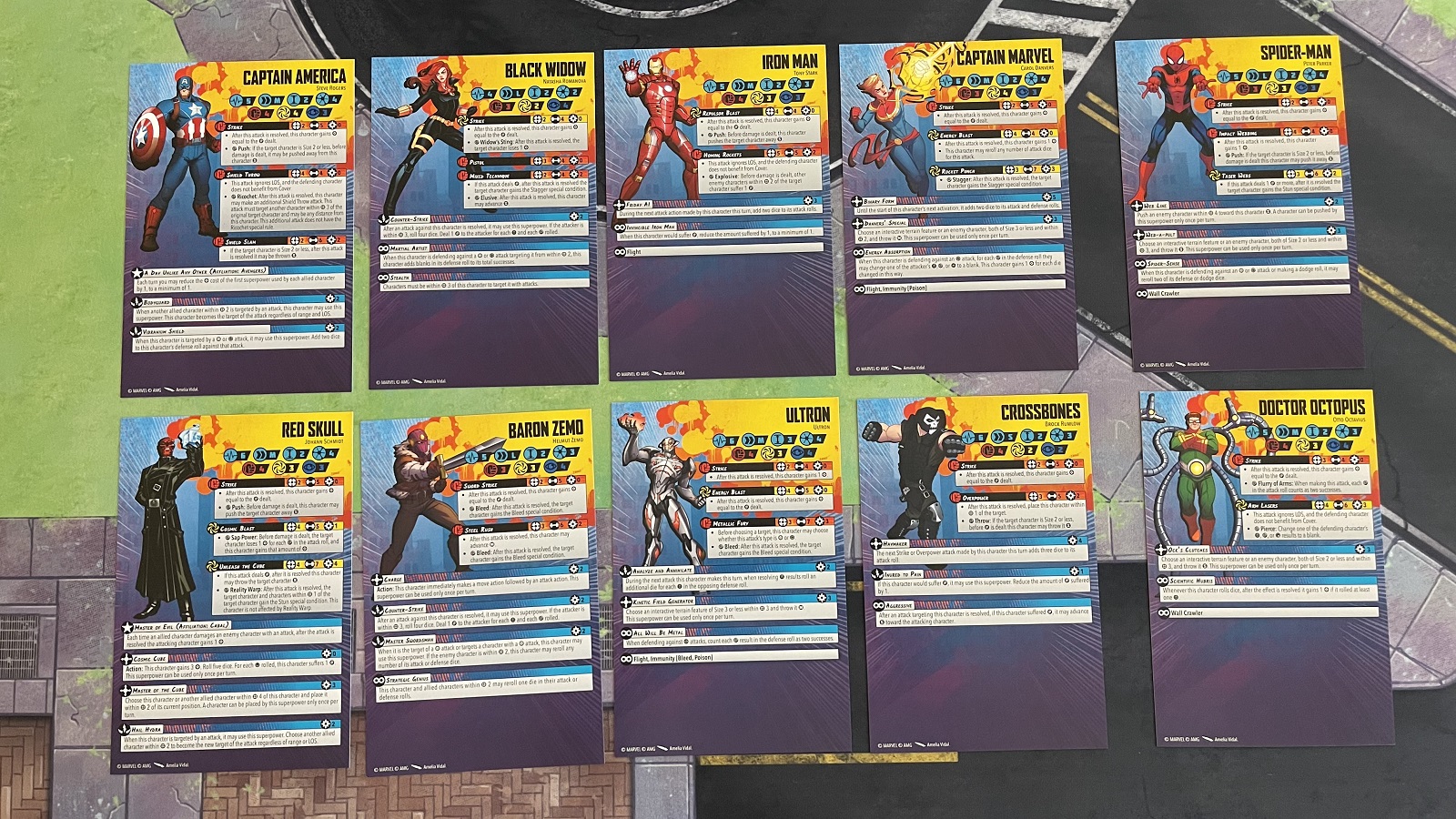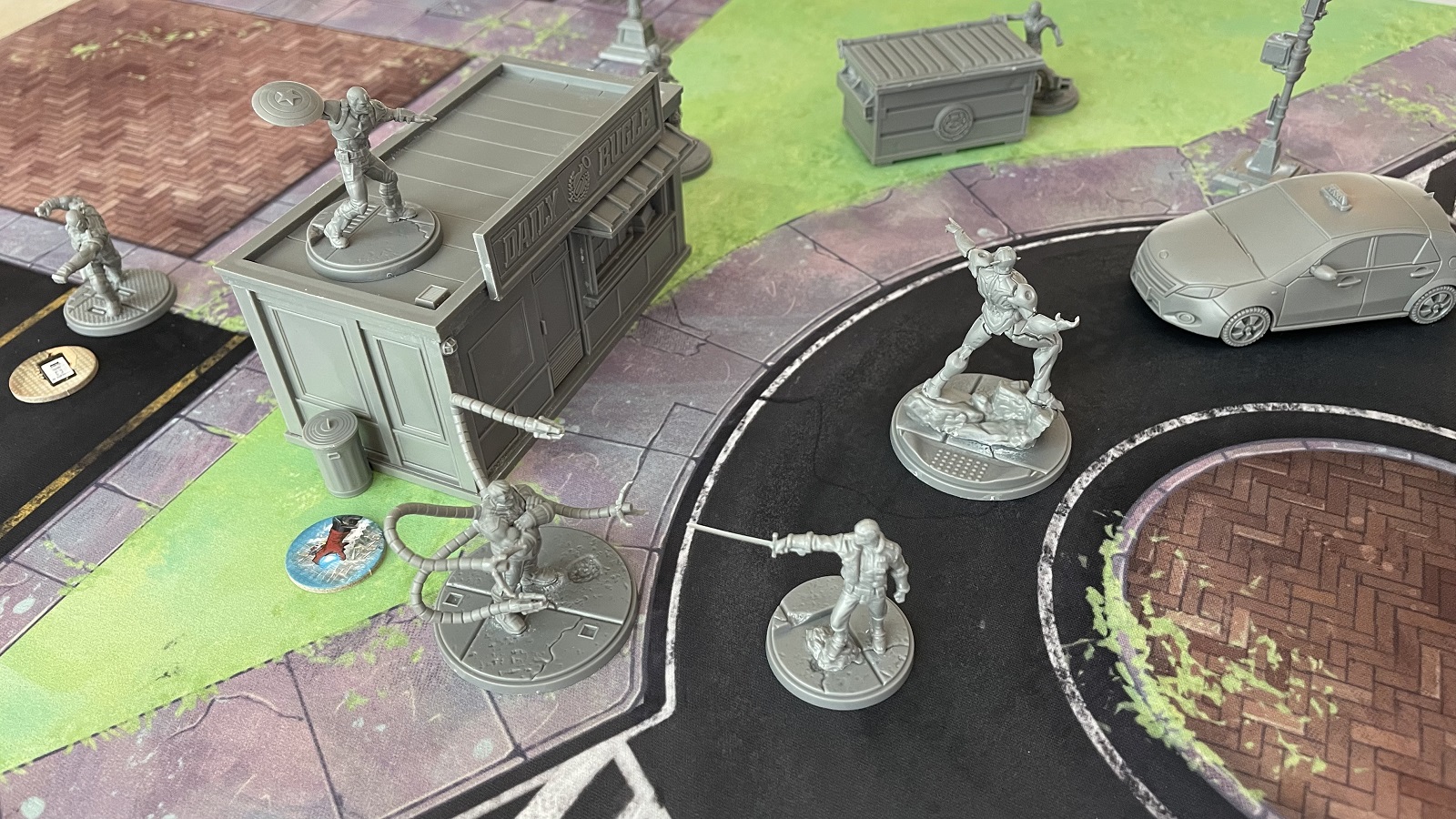
The Avengers are duking it out with some notorious supervillains in New York City. The action is down on the street, in between the buildings and cars. The most famous heroes and villains are here in the thick of it: Captain America, Iron Man, Captain Marvel, Spider-Man, Black Widow, Red Skull, Doctor Octopus, Crossbones, Baron Zemo, and Ultron. Doctor Octopus throws a taxicab at Black Widow while Captain America reflects Iron Man’s repulsor blast around a corner at Ultron. From a vantage point on top of a Daily Bugle news stand, Spider-Man uses his webs to drag Baron Zemo into the open where Captain Marvel can blast him without leaving the objective she is guarding. Trashcans, streetlights, and even buildings are destroyed as the battle tears through a city block. This is Marvel: Crisis Protocol, Atomic Mass’s tabletop hobby miniatures game in which teams of superheroes and supervillains battle it out, fighting for control of key points while attempting to recover people and objects from the battlefield.

The M:CP miniatures game Core Set is intended for starting players and comes with everything that two players need to play a basic scenario. After establishing themselves with the Core Set, players will likely want to purchase additional heroes and villains provided in character packs. Inside the Core Set, you will find a learn to play booklet, cards, tokens, dice, range and movement tools, and ten unassembled plastic miniatures. Happily, included in this box are terrain pieces (also unassembled): a small building, two cars, two dumpsters, two lamp posts and two traffic lights. As far as starter boxes go, the M:CP Core Set is outstanding. It comes with ten well known Marvel heroes and villains and terrain. Terrain is instrumental to game play in almost all miniature war and skirmish games, but few starter boxes include this many terrain pieces. The terrain helps bring the tabletop to life for first time players and for M:CP, being able to use the terrain to inflict damage is part of the game. Since it’s a starter set, there’s not really enough terrain to cover a proper battlefield, players will need more, but it’s enough to get started.
The ten character minis are nicely sculpted recognizable characters from Marvel comics. Eight of the minis should be recognizable to anyone familiar with the Marvel Cinematic Universe version of the characters (including the Spider-Man films), but two – Crossbones and Baron Zemo – maybe not so much. Yes, they are in the MCU, but a casual fan may not recognize those two. Whether a player is familiar enough with the intellectual property to recognize the mini without looking them up or not, there’s no denying that they are outstanding miniatures. At about 40mm scale, these miniatures are larger than most of the tabletop minis you’ll see at your local gaming place. The larger size helps bring out the details and may seem easier to paint to some. There are assembly guides in the back of the learn to play booklet to help glue them together correctly. Most of the minis go together pretty logically but checking the assembly instructions can reduce mistakes. Each character mini is dynamically posed and most convey the kinetic action of a fight. The bases are styled like city streets and sidewalks. As an added perk there are additional litter pieces like crushed coffee cups and bottles attached to extra spaces on some of the sprues. The terrain pieces that come in the box are also well done, they are sturdy, well balanced, and evoke a city street scene. The bottom of each terrain piece has a number on it to remind players of the terrain piece’s size. While the terrain supports a generic city setting, streetlights and cars are commonly found on metropolitan streets around the world after all, the Daily Bugle newsstand adds a dash of Marvel’s New York City to the mix. The movement and range tools are nicely designed and include thematic elements that imply motion and energy blasts respectively.

The cards in the box provide players with all the character and team information needed to play the game. There are ten double-sided character stat cards with images of the character they represent on each side. The information on the card tells the player how tough the mini is, its size and speed, the powers and attacks they have, any special abilities, and how much it costs to put on your team. One side of the card is colored blue, with a fresh character image denoting a healthy mini. The opposite side is toned red and has a beat-up character image representing a mini that has been dazed and is now injured. M:CP minis can be grouped into affiliations based on their comics affiliations, such as the Avengers. The affiliations are not represented on the character cards however, except for faction leaders who have an affiliation-related leadership ability. Instead, affiliations are listed on two additional cards, which have the name of the affiliation (Avengers or Cabal in the Core Set) and a list of characters in that particular group. This allows for characters to be affiliated with multiple groups and for Atomic Mass to modify the affiliations as the game grows. Six Crisis cards, used in combination with three map cards to set up game scenarios, are thematically styled like Daily Bugle excerpts. Finally, there are Team Tactics cards, which players use to give their teams boosts, extra attacks, special maneuvers, etc. The Team Tactics cards with comic book quality art, along with the art on the stat cards, and the Daily Bugle styled Crisis cards, create an immersive Marvel comics experience.
The 170 cardboard tokens in the box are used to help track everything that happens in the game. Common tokens for gameplay include activation, power, damage, and dazed tokens. Aside from gameplay tokens, there are tokens for scenarios with evocative illustrations. For instance, the Infinity Formula tokens have little vials of liquid on them. There are also ten eight-sided dice for resolving combat. The dice are all identical, so there are no different sets for offensive rolls versus defensive rolls. The faces are two hits, one critical, one wild, one block, two blanks, and one failure. When used for attack rolls, hits, wilds, and criticals count as successes. When used for defense rolls blocks, wilds, and criticals. With two hits and only one block on each die, hits are more common than blocks. Two blanks are more common than the one outright failure. Blanks are modifiable results depending on available abilities and cards. For each critical, players roll another die in either attack or defense, likewise, each failure is an unmodifiable failure in both attack and defense. Wilds often trigger secondary effects listed in attack or defense descriptions on the stat cards. The dice function well, giving enough surprising defense rolls to keep it fun, but trending towards more hits, keeping fights consequential.

Allocating time to building the minis is essential, but once players have assembled all the characters and terrain, getting the game going isn’t too difficult. The learn to play guide walks first timers through setting up and running a scenario. Players mark out a 3’x3’ space for the battlefield and place terrain pieces around it. Crisis cards and map cards let the players know what their teams will do and where they will have to go to do it. The minis are set up in start zones along opposite map edges. The guide walks players through the basic game actions, familiarizing them with movement, attacking, and using powers. The learn to play guide does not contain the complete rules, those aren’t even in the box. For the complete rules, players will need to get them from the Atomic Games website. The learn to play guide is an excellent primer for the game and (model building aside) it lets players jump into a game quickly. For some it can be nice to not have to read through an encyclopedic rulebook to get a game going, but players will likely find themselves downloading the rules pretty quickly to clarify game play concepts that are barely addressed in the learn to play book.
Setting up the game involves placing lots of different size terrain pieces on a three foot by three foot playing area and choosing missions. Both players bring mission cards and each provides one randomly to create two missions which will be active during the game. The missions will include placing tokens on the map to indicate items or people to be recovered, or locations to interact with depending on the mission. Once the table and missions are set up and missions chosen the players choose a team from their roster to fight. In the Core Set, for new players, there is a learning scenario that splits the ten characters into two teams. Once players have built up a collection, they will be able to form custom teams for each scenario. The players stage their teams in their starting areas as dictated by their scenario and the game starts.
Everything that goes onto the battlefield, both characters and terrain pieces, has a size. Sizes in the game range from one to five. Human-sized character minis are size two, of the Core Set models only Ultron is larger at size three. Size one terrain includes trash cans, barrels, and mailboxes. Size two terrain is things like dumpsters and cars. Size three is kiosks, food trucks, and the like. Size four includes newsstands and large trucks. And finally, size five is larger buildings. The Core Set comes with sizes one, two, and three terrain pieces. Most terrain is interactive, meaning it can be smashed into and destroyed or thrown around by the characters. When moving, terrain pieces that are the same size as a character or smaller are basically ignored.
Each character has six primary stats: Stamina, Speed, Size, Physical defense, Energy defense, and Mystic defense. Stamina translates to health – characters take damage in the form of stamina loss. The defense stats correlate with the three categories of attack. When an attack comes in, the defense roll is based on the character’s defense against that type of attack. Most characters seem to have decent defense against two types of attack, and weak defense against the third type. The stats and abilities of the minis combine to make each character unique and change the way they play and interact with other minis. To round them out, characters have their own unique attacks and superpowers that they use to fight, control the battlefield, or affect themselves or other characters.

Power is a resource that each mini uses to pay for attacks and superpowers. Each turn, a mini will automatically generate one power. Each mini also has at least one attack that generates power when used. Every time a mini takes damage (loses Stamina) from an enemy effect, that mini gains power equal to the amount of damage. Power starts out scarce, however as the fight develops characters will have a steady supply of it rolling in… but the more power generated by getting smacked around, the less time a mini has to use it before they get knocked out.
M:CP’s basic game play is uncomplicated and lightweight. It is played over six rounds broken into alternating player turns. The players maneuver their minis across the battlefield to accomplish team objectives determined by a pair of Crisis cards. The pair of Crisis Cards always consist of an Extraction Crisis card that requires recovering objects from the field and a Secure Crisis card that requires holding objectives placed on the table. Player strategy is generally based on which Crisis cards they want to go for and which ones they want to prevent their opponent from achieving. Points are scored at the end of each round based on which minis are holding objective tokens or securing objectives based on the scenarios dictated by the Crisis cards. This dual Crisis card method for creating missions helps add variety to the game. With three of each in the Core Set, players start out with nine different scenario combinations out of the box, with additional cards coming with expansion characters. The Core Set comes with ten characters, so for learning and starting out, one Core Set will work for two people, but eventually, each player will likely want their own Core Set along with expansion characters. Before getting together to play, players will create a roster of ten characters that comprise their team.

Each round is broken into three phases: the Power Phase, the Activation Phase, and the Cleanup Phase. During the Power Phase, each character gains one Power token and the Cleanup Phase allows for bookkeeping like awarding Victory Points and removing Knocked Out characters from the game. The Activation Phase, sandwiched in the middle, is where the main gameplay occurs. In the Activation Phase players alternate activating minis. Each activation allows the mini to take two actions, choosing from Move, Attack, Superpower, and Shake. The rounds flow pretty simply, although there is always the time spent pondering the best moves and measuring. Within the framework of each round, complications about the best way to execute a plan can make the turns balloon out to fill the time. An indecisive player can slow things down, just like any game, and unfamiliarity with the powers and abilities of your characters can slow things down as players read and reread cards to try to decide what to do.
Movement is handled via a pivoting tool system, similar to other recent minis games. There are three plastic movement tools of different lengths (short, medium, and long) that pivot in the middle, ninety degrees in either direction. For a basic movement forward (an advance), players use the movement tool that matches their character’s Speed stat or a shorter one. They place it on the table with one end touching their mini’s base and bend the tool in whatever direction they want. Then they pick up their mini and place it anywhere they want touching the movement tool. Other types of movement include being pushed, climbing, throwing, or placing (to teleport, for instance). Terrain pieces that are the same size as or smaller than a character can be ignored during movement, otherwise they have to go around or climb over the obstacle. To climb onto a larger object, any character uses the shortest movement template and uses it to put themselves on top of a building, so you have to get close enough to initiate the climb. Ignoring terrain that is the same size or smaller than the character makes movement easy and thematic. This allows a size two superhero to easily vault over the hood of a car and rush past a trash can. But if they’ll have to climb to the top of a size three building or go around it. Two abilities— Flight and Wall Crawling — make characters act as if they are size five when moving, meaning they can ignore all terrain. There is no other apparent difference between Flight and Wall Crawling, which is irksome. It works well for the movement rules, but without any ability to stick Spider-Man on the side of a piece of terrain or have Captain Marvel float in the air, the effects are identical. I wonder if there isn’t something else that could have been done to make Spider-Man’s movement different from Captain Marvel’s. Additionally, movement can feel a bit oversimplified, with everyone sliding over cars and rushing through dumpsters, a good percentage of the terrain feels more like flavor than obstacles.

Attacking is simply a matter of choosing an attack from the list on the mini’s Stat card and targeting another mini with it. Attacks come in three forms, Energy, Physical, and Mystic. Everyone has an attack that costs zero Power to use, usually a short-range strike, which comes with a benefit of accruing some Power for the attacker. Other attacks cost Power to use. Almost all attacks come with some additional effects beyond just doing damage. The additional effect can be a benefit for the attacker, or an additional effect on the defender, usually triggered by rolling a specific face (often a Wild) on at least one die in the attack roll. In any case, players choose an attack, roll the dice equal to the strength of the attack and the defender rolls a number of dice based on the strength of their defense against that type of attack. Critical hits add an extra roll. Some abilities grant rerolls. At the end of all the die rolling, if the attacker rolled more hits than the defender blocked, the extra hits equal damage which is taken against the Stamina stat. Interestingly, for every point of damage a character takes in combat, that character earns a point of Power. So, a character that takes a licking one round, but isn’t Dazed or Knocked Out, will have a lot of Power to use during their next activation.
Speaking of Dazed or Knocked Out, those are the two consequences of taking too much damage. The first time a character’s damage exceeds its Stamina, it is Dazed. The character cannot do anything or be attacked and is effectively out of the game for the rest of the round. At the end of the round in which a character is Dazed, the character’s Stat card is flipped from the blue, healthy side to the red, injured side and everything is reset for that character. The second time a character’s damage exceeds its Stamina, it is Knocked Out and removed from play. A few Stat cards are different on the back, for instance, Captain America gains a superpower called, “I Can Do This All Day”, but for most, the only difference is the color and the picture (injured looks a little beat up). It’s a bit surprising that differences between healthy and injured are rare. Clearly decrementing every character when it is injured would lead to the first player to Daze an opponent gaining an advantage that could compound, making it difficult for the first blooded to win. But at the same time, I wonder if the injured sides could have shown a shift between offensive stats and defensive stats, indicating a level of caution taken by the injured character. As it is, the blue versus red side of a card is just a bookkeeping process.

Other key wargame gameplay components are addressed with relative simplicity. Line of sight is simply straight-line base to base – mini poses or size isn’t a factor. As long as you can draw a straight line from any part of a mini’s base to any part of another mini’s base without hitting an object, you have line of sight. Cover works similarly, as long as a piece of terrain blocks drawing a straight line from any portion of one mini’s base to any portion of another mini’s base, the terrain is providing one of them cover. For both line of sight and cover, there are a few additional rules, but they are basically simple. Considering terrain, hurling pieces of terrain or even other characters around is commonplace in comic books and the same is true in M:CP. When collisions happen between objects and characters, objects can be destroyed, and the characters can take damage. To avoid damage from a collision, characters dodge by rolling their Physical defense, successes subtract from the damage they will take from the object they are colliding with — based on its size plus one. So, if a character gets smacked with or smacks into a size two car, they could take 3 damage.
Victory points are earned by controlling objectives and keeping the opponent away from it, or by collecting up objectives and keeping them out of opponents’ hands. Because each game is built on a combination of two different types of Crisis cards, both types of objectives are in play every game. Throughout the game, team members work together, using their powers to complement each other. To further add to the synergy of a team, each player has Team Tactics cards that give bonus actions, special abilities, and other perks. Well timed Team Tactics cards can change the direction of a fight, help out in a critical spot, or just mess up your opponent’s plans. Each player has five of them selected before the start of the game and they are not secret, so your opponent knows what you can do. Team Tactics cards come in different varieties, and there are a bunch to choose from. Some of them are faction specific and can only be used if your superheroes are using that faction, so if you want to use an Avengers Team Tactics card, you need to have at least half of your team composed of Avengers and declare that they are fielding as Avengers. The Team Tactics cards, combined with the factions and the characters’ flavorful superpowers provide a huge amount of variability and cinema to the game.
The simple rules and light approach to line of sight and movement won’t be for everyone. Hard-core gamers, especially tournament experienced wargamers will likely not like the lack of granularity in the rules. Premeasuring is allowed and the movement rules allow for a lot of eyeballing it, rather than precise measured movements. The tradeoff is a game that feels more like a popcorn and soda filled visit to the movies than a gritty fight between superpowered heroes and villains. I’m not saying that tournaments can’t happen, in fact they already do, but I do think that even those tournaments are happening within a framework that requires the player to be more forgiving of placement and line of sight than other tabletop minis games. It’s possible that future rules can provide the crunch that hardcore gamers might wish for, but until then, it’s likely to not hit their table often.
Marvel: Crisis Protocol
Excellent
Playing the Marvel: Crisis Protocol is a fun and breezy experience. Even though terrain is integral to game play, it’s not overly complicated to use and it adds immensely to the cinematic nature of the game. Maneuvering around the battlefield is not difficult or time consuming. Since you aren’t concerned about base-to-base contact to fight, just getting within range of your opponent is usually enough to attack, you aren’t overburdened with getting your movement exactly right. The variety of the various attacks and powers lends to the comic book feel of the game – the characters feel right. Hurling a car or dumpster across the battlefield is great fun. The rules are probably too light for some, but they do what they are supposed to do. Overall, playing the game is as much fun as reading the comics or watching the movies it's based on. It can't get much better than that.
Pros
- Excellent minis and terrain
- Cinematic play provided by flavorful abilities and cards
- Simple rules and streamlined play
Cons
- Flight and Wall Crawling effectively the same thing
- Movement in and around terrain may be oversimplified
- Injured side of cards statistically identical to uninjured for most minis
